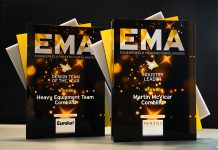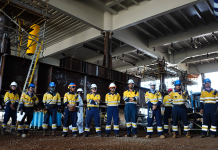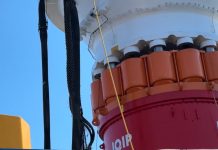With global expenditures for wind turbine operations and maintenance rising due to an increasing number of installations and aging turbines, higher attention is being placed on the value of O&M as it relates to the life-cycle cost of a project. According to GlobalData, one of the world’s leading data and analytics companies, a wind farm’s O&M costs account for approximately 10-15 percent of the total cost of power generation in an onshore wind farm and 25 percent in an offshore wind farm. In an effort to realize more economy through technologies, wind farm owners and operators are beginning to understand the implications of designing and constructing with an eye for long-term O&M. This makes wind construction companies with an internal O&M department highly attractive.
Wanzek Construction, Inc. is one such company. As an engineering, procurement, and construction (EPC) contractor and an established O&M independent service provider (ISP) with an extensive in-house equipment fleet, Wanzek offers solutions that have positive impacts on the life-cycle cost of a project. Wanzek takes an expanded approach to planning and working with owners to map out lean processes and technologies that affect both construction and maintenance costs. The company looks to all aspects of construction and maintenance for opportunities to manage risks associated with degraded wind farm performance to optimize projects in the longterm.
Planning and Lean Processes
As an ISP, Wanzek is in the position to serve both owners and original equipment manufacturers (OEMs). Most OEMs aren’t equipped to perform all maintenance services in-house. This means that despite the trend toward longer turbine warranties and supplier agreements, companies like Wanzek have a wide-range of opportunities.
Jake Nikle, O&M Services Division manager at Wanzek, said that he welcomes the move toward longer supplier agreements.
 “Extended warranties support an owner’s long-term objective,” Nikle said. “The wind power industry is still developing in many ways. Working with OEMs on their maintenance needs gives us insight into new technology as well as what’s in store for the future. Our teams are interested in investing in a site for the life of a project. To us, that means looking at the big picture. Through our lean and quality processes, we focus on the long-term health of a project before construction even begins and continue to look for ways to optimize productivity long after the last turbine has been erected.”
“Extended warranties support an owner’s long-term objective,” Nikle said. “The wind power industry is still developing in many ways. Working with OEMs on their maintenance needs gives us insight into new technology as well as what’s in store for the future. Our teams are interested in investing in a site for the life of a project. To us, that means looking at the big picture. Through our lean and quality processes, we focus on the long-term health of a project before construction even begins and continue to look for ways to optimize productivity long after the last turbine has been erected.”
In 2014, Wanzek hired lean Six Sigma Master Black Belt Karen Tucker to lead their Quality and Development Group. Over 130 team members have been trained in methods of lean continuous improvement and are applying those methods to all construction and business processes within the company. Team members can earn a yellow belt in continuous improvement through Wanzek’s Operational Excellence initiative. According to Tucker, this is what sets Wanzek apart in the wind industry.
“Anyone can come in with construction services, but Wanzek also offers lean continuous improvement to assist customers by optimizing the process from beginning to end,” Tucker said. “We can eliminate waste within the process and develop plans to proactively reduce risk and improve the outcome of the process. The modern construction toolbox doesn’t only contain wrenches and hammers, but also software tools like Value Stream Mapping and Failure Modes Effects Analysis.”
According to Nikle, the lean approach is applied to every project Wanzek takes on.
“If we are able to take two days at the beginning of a project and outline a way to get a 10-hour process down to nine hours, the efficiency that is created over the course of the project is huge,” Nikle said.
Consulting Services
The company also offers consultations at the onset of both construction and maintenance projects. Wanzek recently used the failure modes effects analysis (FMEA) tool to proactively identify problems that could occur during the grout installation process of wind turbine construction. FMEA is a problem-prevention tool used to anticipate what might go wrong with a product or process and to create plans to mitigate the risk of failure. During the FMEA conducted on a wind turbine generator project, Wanzek identified possible grout installation failure modes and proactively took steps to mitigate the risk. Through this process, the highest ranking risks are addressed first with countermeasures to offset and prevent failure mode from occurring.
“We’re doing exciting things at Wanzek with the principles of lean continuous improvement,” Tucker said. “We are addressing risks proactively and preventatively rather than relying on inspection and correcting defects at the end of the process.”
Two other areas of construction where close attention to detail is key are the electrical and civil sides of the job because, according to Nikle, cutting expenditures and saving money at the onset of a project can become costly later.
“Construction solutions such as installing an increased number of circuit breakers and switches can allow the majority of a project to continue generating while maintenance is being performed on part of a site,” Nikle said. “An owner is much better off maintaining 80 percent of operation during maintenance rather than having a full outage.”
Civil work can also minimize future costs. Taking time to plan roadway layouts can make a large impact on maintenance budgets.
“We offer a focus on civil design that minimizes impact to environmentally sensitive areas,” Nikle said. “We often encounter challenging terrain, such as a curve or bend that directs water flow and can prevent wash-outs or fissures that lead to ongoing maintenance. For a hilly site, this can make a huge impact. Thoughtful placement of catch basins and drainage channels can also save money in the long run.”
 Systematically Improving O&M
Systematically Improving O&M
Wanzek also successfully applied lean processes to O&M projects to identify waste in the maintenance process and took action to reduce required man-hours. These events also serve as a forum for the exchange of ideas and best practices across multiple client-operated sites. Applied at the onset of a job, this approach can result in improved turbine performance, reduced time resources, substantial procedural improvements, and improved daily output. Wanzek put this into practice last year during a maintenance-specific lean event for a client where preparation included a review of the processes and procedures that were in place. Through the use of value stream mapping, Wanzek found that procedures overlapped and that task performance required technicians to move throughout the turbine without regard for the amount of time spent on a task. This led to a focus on the reorganization of crews and responsibilities. With Wanzek’s direction, the client developed a maintenance program made up of four crews performing tasks directly related to the area in which they work. Wanzek followed-up with modifications to ensure standardization of the improvements. The result was a reduction of over 50 percent in man-hours per turbine.
“We’re making processes as efficient as they can be, improving quality, and redefining what excellence is all about,” Tucker said.
Empowering Teams
With the recent surge in wind projects across the country, Wanzek has seen continual growth. In response, the company has implemented an integrated growth and development strategy that facilitates higher levels of communication and distribution of project information. For the wind team, this involves an ongoing, organized assembly of various roles from vice president of the division to estimating, project management, and construction managers. Planning and lean events are core aspects of each meeting. Nikle said that he believes that this strategy is imperative to develop the team mentality that is required to consider the full view of a project.
“This strategy is focused on developing our personnel and procedures to ensure we are continuously evolving and improving as a team,” Nikle said. “As we’ve grown, we have had people who have worked through the ranks, touching various levels of wind projects. Through this program, we consistently review all tasks and training. We get a chance to empower the next generation of crews.”
The company has also expanded and optimized its internal training program. This has seen a gain in productivity as well as employee motivation and retention. The training curriculum has been customized to allow employees to focus directly on specific organizational goals and strategies.
Applying Technology
An integral aspect of implementing insights gained through planning and lean events, Wanzek’s mobile vision plan (MVP) was developed to optimize performance standards. Driven by core technology goals, the plan has been instrumental in streamlining job-site documentation, enhancing collaboration between corporate and field team members, improving workflow on job sites, and enabling job site mobilization.
This smart job site initiative has expanded use of mobile devices in the field, establishing daily integration of information with the company’s back-end systems and allowing field and corporate management teams access to real-time information. This has increased interdepartmental collaboration and continually provides team members in the field with access to timely information.
Nikle said he is enthusiastic about the efficiencies he’s seen as a result of Wanzek’s MVP.
“I think wearable technology is where we are headed,” Nikle said. “Being able to project procedures on a wearable screen would be valuable as would a wearable pack that monitors specific crews and provides information regarding crew locations and working conditions. Adopting technology in the field is necessary to evolve with industry demand.”
For now, Wanzek actively implements the use of job site mobile devices including smartphones, site kiosks, and tablets. These allow employees in the field to capture pertinent information on a daily basis that is integrated with the company’s corporate back-end systems. The Wanzek app, a mobile tool that facilitates the push for real-time data and communication, has just been released.
Whether it’s employing technology or using a simple spreadsheet to analyze project waste, Wanzek is driving excellence through innovation in methodologies and tools. This is generating enthusiasm both in the corporate office and in the field. Tucker said that she attributes this to working for a company that understands the significance of staying on the leading edge.
“The modern construction toolbox doesn’t contain only wrenches and hammers, but analysis tools and technological devices as well,” Tucker said. “That is what makes it an exciting time in the construction industry.”
For more information, go to wanzek.com.



























